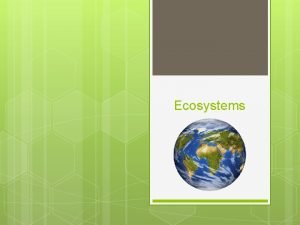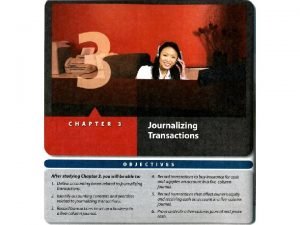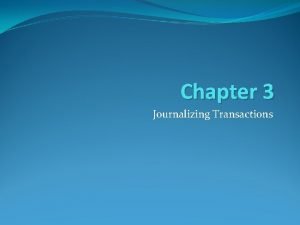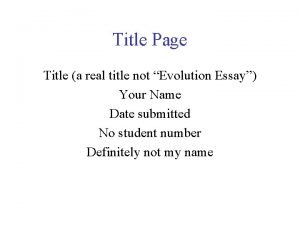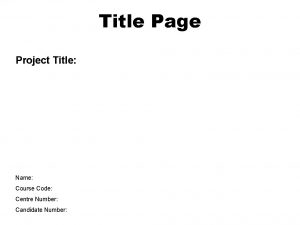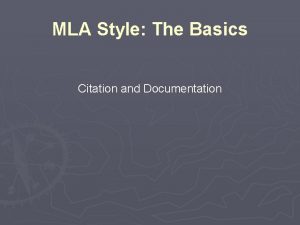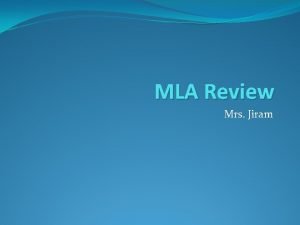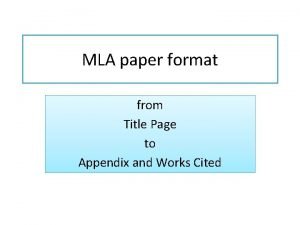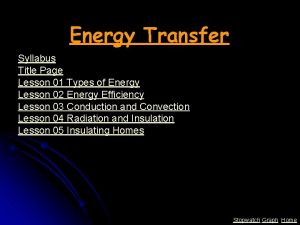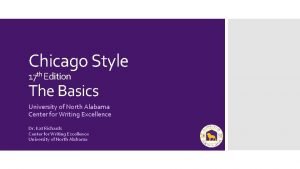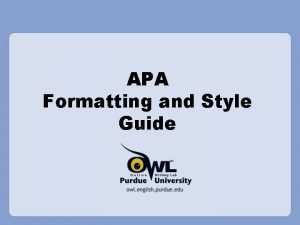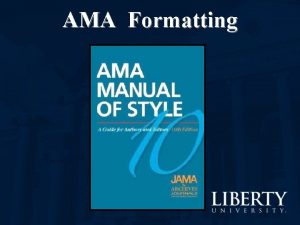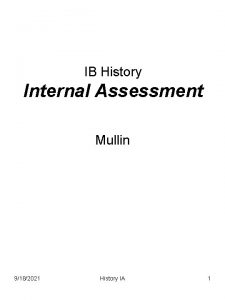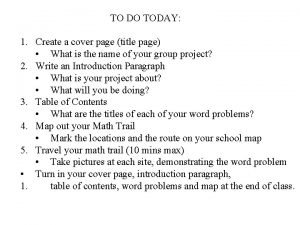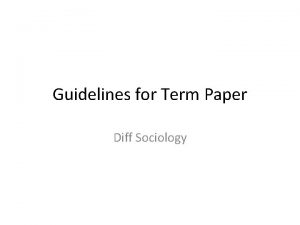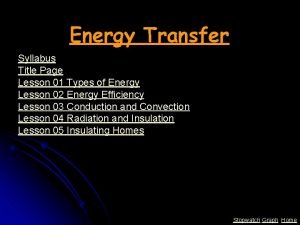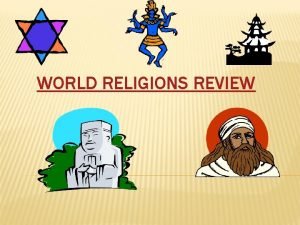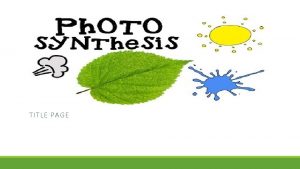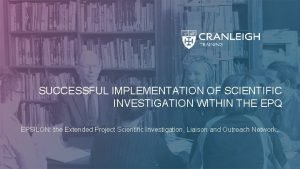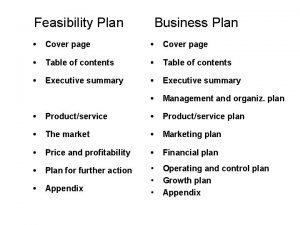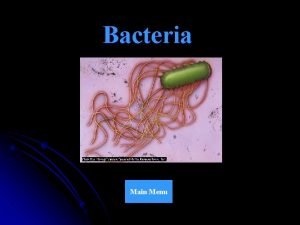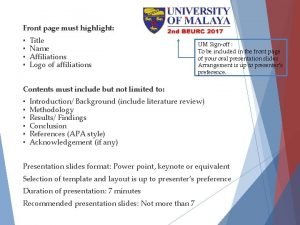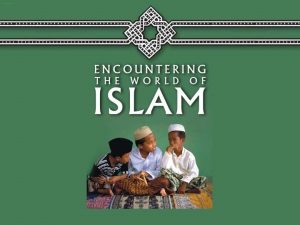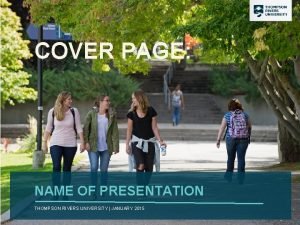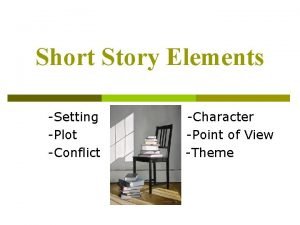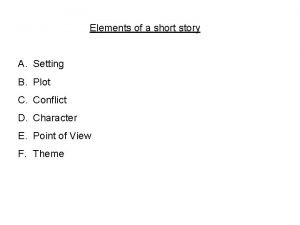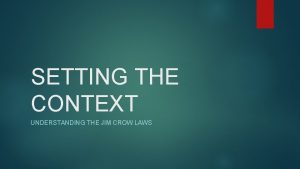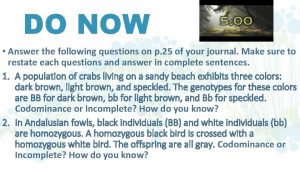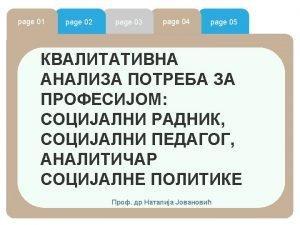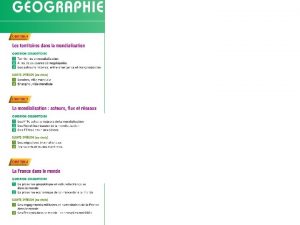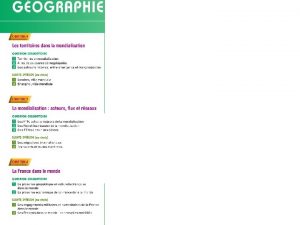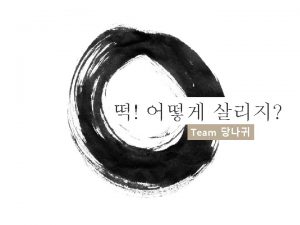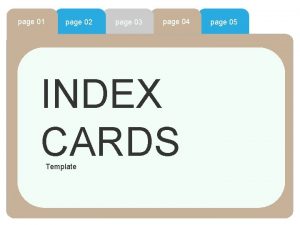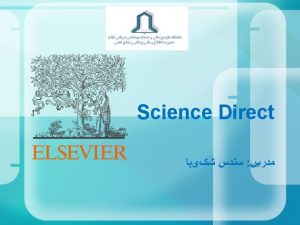Ecosystems Setting Up Your Journal Title page Ecosystems












































- Slides: 44

Ecosystems

Setting Up Your Journal ○ Title page ○ ‘Ecosystems’ should be written on the page and you should include illustrations.

○ Table of Contents – page 3 ○ ○ ○ Page 4 – Essential Questions Pages 5 -7 - Vocabulary Essential Questions ○ ○ ○ In what ways are environmental systems connected? How do changing environmental systems affect organisms, including people? How does the location on Earth impact the characteristics of an ecosystem?

Vocabulary ○ Ecosystem: all the populations of living and nonliving things in an environment and the interaction among them ○ Biome: a large scale ecosystem ○ Biomes Worksheet ○ ○ Read and highlight information Glue into journal Add to Table of Contents Land Biomes Brain Pop

Rainforest Biome Make up about 7% of Earth’s surface, yet contain more than 50% of all plant and animal species on the planet Warm and wet year-round, never below about 75 degrees fahrenheit 78 inches to 354 inches of rain annually Three major layers: Canopy: Top layer, where thick leaves and tall trees form an “umbrella” over the forest Understory: Shorter trees, bushes, and ferns, and the animals that live there. Forest floor: Very little sunlight reaches the forest floor. Bugs, insects, and snakes make this place their home. ○ Rainforest video

Rainforest Biome examples Canopy Layer Understory Layer Forest Floor Layer

Deciduous (Temperate) Forest ○ ○ ○ ○ Average temperatures and average amount of rainfall Exists on every continent, except Antarctica and Africa Trees shed their leaves each year Multiple seasons occur due to the amount of sunlight Several layers of plants can be found here Tall trees (which create a canopy) let light reach the bottom where bushes and smaller trees grow (unlike in the rainforest) ○ These plants provide a variety of habitats for animal life

Taiga Biome (boreal forest) - One of the 3 forest biomes, and has the largest total land area. - Coniferous, evergreen trees have thin needles that have adapted to collect rain - Total rain is only between 12 to 30 inches a year - 6 month winters that can average -60 degrees fahrenheit -Short, hot summers; because it’s so far north, the sun hits it directly - Animals have adapted with thick fur to survive the winters. Other animals will hibernate or migrate to stay safe. - Has many bogs- swampy pools of water and dead plants that have collected over time. ○ Taiga Biome

Taiga Biome examples Summertime in the Taiga Top-down view of bogs Taiga biome in winter

Tundra Biome -Three types of Tundra: Arctic tundra, Antarctic tundra, and Alpine tundra. - Arctic tundra has many flat plains with no trees ○ Formed from retreating glaciers - Covered in ice and snow for seven to eight months of the year - Winters can reach -90 degrees, Summer temperatures rarely hit 50 degrees - Permafrost layer beneath the surface layer always remains frozen - In summer, the surface layer can melt, creating ponds and wet ground that will allow certain plants to grow. - Arctic and Antarctic tundras are cold deserts with less than 10 inches of rain annually. - Alpine tundras exist on mountaintops all over the world. ○ High winds and heavy snowfall ○ Tundra Biome

Tundra Biome examples Arctic fox - coat turns white in the winters for camouflage Antarctic tundra with moss growing (Summer) Alpine biome

○ Grasslands/Savanna Biome video ○ Grasslands, Savanna, Prairie ○ ○ ○ also known as Savanna(Africa) or Prairies(North America) mainly have grasses growing and few trees little rain long slender leaves allow little water loss in plants Write down other info you found important from the video

○ Desert Biome video ○ Deserts ○ ○ ○ ○ soil and air are dry little rain sun shines most of the time temperature hot in day (summer) and can be freezing at night (winter) few plants: cactus and bushes snakes, lizards, few mammals like rabbits Write down other info you found important from the video

○ Mr. Parr's Biome song ○ ○ Terrestrial = land Aquatic = water ○ Aquatic Ecosystems ○ Learn about the difference between a freshwater ecosystem and a saltwater ecosystem

Water Biomes ○ Water-based regions home to a unique group of living things.

Wetland ○ ○ ○ ○ Also known as swamp, marsh, or bog Land covered with shallow water for all or part of the year Water comes from rain, melted snow, underground spring Marsh-grassy with reeds and cattails near river or lake Bog- found in cool climate, spongy peat moss Swamp- forested wetland full of trees and shrubs Everglades Brainpop video Bill Nye the Science Guy – Wetlands

River ○ ○ ○ ○ A ribbon of water that weaves over land Constantly moving and changing Can carve canyons and form waterfalls Water comes from melted snow, springs, rainwater, underground Water flows downhill Underwater plants anchor in the river bottom Water level drops and rises depending on rain fall. Rivers Brainpop video

Lake ○ ○ ○ A pool of freshwater that fills low spots in land Form from mountain snow, natural springs, along rivers, or behind dams Trees line the sides of the lake Water lilies grow on top of the water Tall grasses are on the water edge

Estuary ○ ○ ○ Where a river meets the ocean Part wet part dry Forms brackish water (fresh water and salty water mixed) Found on edges of continents and islands Experience high and low tides Mud is full of nutrients

Ocean ○ ○ ○ Covers 75% of earths surface Very salty Largest water biome Waves move water and has high and low tide Sea weed and algae grow Deep water gets no light so few producers and cold temperatures

Vocabulary ○ Organism: an individual plant, animal, or singlecelled life form ○ Individual: a single organism in an environment ○ Population: individuals of the same kind living in the same environment ○ Community: all the populations of organisms living together

Vocabulary ○ Habitat: a place in an ecosystem where a population lives ○ Niche: the role each population has in a habitat

Vocabulary ○ Producers: organisms that use sunlight to make the food they need from carbon dioxide and water ○ Consumers: all organisms in an ecosystem that eat to get the energy they need ○ Decomposers: consumers that break down the tissues of dead organisms

Biotic and Abiotic Factors ○ ○ ○ Abiotic: a non-living organism Biotic: a living organism ‘A’ = not ‘Bio’ = living http: //www. pbslearningmedia. org/asset/lsps 07 _int_ecosystem/

Venn Diagram Abiotic -Water -Glass -Sand -Plastic -Dirt -Gold -Oxygen -Rocks -Temperature -Clouds -Hair Biotic Desert Tundra Ocean -Whale -Coral -Mushroom -Snail -Paper -Trees -Steak -Mold -Hair follicle -Grapes -Athlete’s Foot -Salad -Grass

Comprehending ○ 1. If all of the rocks ( A ) are removed from a desert ecosystem, what would happen to the population of rock dwelling lizards ( B ) and in turn the animals which eat them? ○ 2. A ten mile area of trees ( B ) is removed from the tropical rainforest. How will this affect the amount of water ( A ) and the amount of oxygen ( A ) in the area?

Producers ○ ○ A Producer is a living that makes its own food. Plants, grasses, shrubs, and trees are examples of producers. Other examples include algae and bacteria. Plants use the energy in sunlight to make or produce their own food.

Consumers ○ ○ ○ Animals and people can’t produce their own food. A Consumer is a living that gets energy by eating other living things. All animals are consumers.

Consumers Continued ○ There are three types of consumers ○ Herbivores: consumers that eat only or mostly plants. ○ ○ Carnivores: consumers that eat only or mostly animals. ○ ○ Mice, rabbits, deer, and insects. Sharks, walruses, cats, lions, foxes Omnivores: consumers that eat both plants and animals. ○ Pigs, bears, raccoons, and humans.

Decomposers ○ ○ Living things give off waste material. A decomposer is a living that gets energy by breaking down wastes and dead plants and animals. Decomposers break the material down into simpler materials which become part of the soil that helps plants grow. Examples: bacteria and fungi such as mushrooms.

The Flow of Energy in Ecosystems ○ http: //studyjams. scholastic. com/studyjams/jam s/science/ecosystems/food-chains. htm

Food Chains ○ ○ A food chain is a model that shows the path of energy from one living thing to the next. If one kind of organism is removed from this food chain, all the other organisms in the food chain will be affected.

Food Web ○ ○ A food chain shows the flow of energy from one living thing to the next. Several food chains connect to form a food web. http: //studyjams. scholastic. com/studyjams/jam s/science/ecosystems/food-webs. htm Food Chains and Webs - Brain Pop

Example of a Food Web

Energy Pyramids ○ ○ Energy moves through ecosystems. It goes from small animals to big animals to the biggest animals. As each animal eats it stores only the energy it gets from the plant or animal it eats. The bottom level always contains producers and holds the most energy.

Energy Pyramids Continued ○ ○ ○ Each higher level contains less energy and fewer living things. The carnivores are at the top of the energy pyramid and contain least amount of energy. https: //www. brainpop. com/science/energy/ene rgypyramid/preview. weml

Energy Pyramids Each level gets 10 x less energy than the level below it.

Competition ○ ○ ○ Competition: the contest among organisms for the limited resources of an ecosystem Organisms compete for water, food, shelter, and sunlight Every animal has adaptations that help it compete for resources ○ ○ ○ Camouflage (or patterns of body color) and hunting in packs are two examples of adaptations In some communities, animals live together and share resources. These animals do not directly compete with one another. Study Jams - Animal Adaptations

Symbiosis ○ ○ ○ ○ Symbiosis: a long term relationship between different kinds of organisms Different kinds of organisms often live closely together for most or all of their lives. Symbiosis may benefit both organisms or it may only benefit one and not the other (commensalism) Parasitism is when one species grows stronger by harming another species A relationship where both organisms benefit is called mutualism. ○ Flowers and bees and cleaner fish and sharks are both examples of mutualism. Symbiosis - Study Jams Symbiosis - Brain Pop

Instincts and Learned Behaviors ○ ○ Some animal behavior is inherited and some is learned. Instinct: a behavior that an organism inherits ○ ○ Shared by an entire population (or some only for males and some only for females) Examples include building shelters and finding mates ○ Squirrels instinctively bury acorns and Canadian geese fly south for the winter

○ Learned Behaviors: behaviors animals learn from their parents, not inherit from them. ○ ○ ○ Young lions must learn hunting skills from adult lions in order to survive Birds learn what kind of nests to build from adult birds Brain Pop – Behavior

Inherited Traits ○ ○ ○ A trait is a quality or characteristics of a living thing. A behavior is a way in which a living thing acts or responds to its surroundings. You inherit the color of your eyes and hair and the shape of your nose. If you can roll your tongue you were born with this trait. These traits are passed from parents to offspring. Plants inherit ways of responding to their surrounding such as roots grow down and toward water. Stems grow up toward the sun.

Acquired Traits ○ ○ ○ ○ ○ Not all traits are inherited. An acquired trait is a characteristic that a living thing gets during its lifetime. Acquire=to get A scar is a physical trait that is acquired. Many acquired traits are learned behaviors. Example: young chimpanzees learn to use sticks as tools to get food. You were not born knowing how to speak or read a book. Brain Pop – Heredity Study Jams - Heredity

Inherited Traits and Acquired Traits Inherited Traits Acquired Traits A girl has brown eyes. A girl can speak Spanish. A boy has long fingers. A boy knows how to play the piano. A plant has red flowers. A plant’s leaves have spots from a disease. A bird knows how to build a nest. A bird knows where to find a feeder. A tree has large, round leaves. A tree’s trunk is bent by the wind. A dog has curly fur. A dog knows how to fetch on command.
 Climatespongy.com
Climatespongy.com Abiotic factors examples
Abiotic factors examples Apa format
Apa format Writing and completing reports and proposals
Writing and completing reports and proposals Information for each transaction recorded in a journal.
Information for each transaction recorded in a journal. Journalizing transactions
Journalizing transactions Cover page essay
Cover page essay Evolution title page
Evolution title page Project title page
Project title page Andrea dottolo
Andrea dottolo Mla title page
Mla title page Mla cover page format
Mla cover page format True or false mla requires a title page
True or false mla requires a title page Example of appendix in research
Example of appendix in research Energy title page
Energy title page Chicago style title page
Chicago style title page Apa reference with et al
Apa reference with et al Ama format title page
Ama format title page Proposal cover page
Proposal cover page Title page abstract
Title page abstract History ia ib
History ia ib Title page for a business plan
Title page for a business plan Asa table format
Asa table format Math title page
Math title page Title page verso
Title page verso Forces title page
Forces title page Sociology title page
Sociology title page Best engineering notebook
Best engineering notebook How to draw sankey diagram
How to draw sankey diagram Religion title page
Religion title page Cells title page
Cells title page Epq contents page
Epq contents page Business plan cover page
Business plan cover page Classification title page
Classification title page Front name style
Front name style Islamic title page
Islamic title page Inistin
Inistin Title title
Title title Short story with characters setting, and plot
Short story with characters setting, and plot Setting in a short story
Setting in a short story Give us your hungry your tired your poor
Give us your hungry your tired your poor Understanding jim crow (setting the setting)
Understanding jim crow (setting the setting) Answer the following questions in your notebook.
Answer the following questions in your notebook. In your journal notebook answer the following questions
In your journal notebook answer the following questions Open your textbook
Open your textbook

